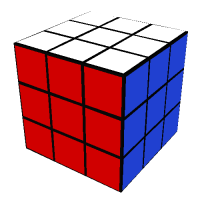Notation
In order to write down sequences of movements on the cube, we use a notation of six main letters:
- U for Up
- D for Down
- L for Left
- R for Right
- F for Front
- B for Back
These letters are used in sequences known as algorithms, and you just perform each letter in the algorithm from left to right. Each letter simply tells you to move that face clockwise by 90 degrees. An apostrophe after a letter (like F', said 'anti-front') tells you to move that face anticlockwise instead, and 2 after a letter (like R2) tells you to move that face by 180 degrees.
Here's an example for you:
 F2 B2 U2 D2 L2 R2
F2 B2 U2 D2 L2 R2If you managed to followed that correctly by turning each face of your cube twice, you should have achieved a rather charming checkerboard pattern. Use this simple algorithm to impress your friends and family!
You may have noticed that you could touchhover over each move in the algorithm to follow along at every step. If you're feeling a bit confident, you can turn this off using the 'Algorithm helper' switch at the bottom of the menu.
It is important to remember that each move should be done as if you were looking directly at the face that the move affects. U and D are clockwise turns for the Up and Down faces, but if you turn the top and bottom layers in the same way while looking at the Up face for both moves, you actually perform U and D'. Use this helpful array of buttons to see how each move affects a solved cube, so you can see how to perform them correctly.
Advanced Notation
For the intermediate and advanced methods, other letters for notation will be used. These include:
- x for rotating the cube like an R
- y for rotating the cube like a U
- z for rotating the cube like an F
- M for the layer between L and R
- E for the layer between U and D
- S for the layer between F and B
E and S are used very rarely, as they are quite awkward to perform and can easily be replaced in algorithms with other turns.
There are also lower case letters for double layer turns, which mean to turn the normal face and the middle layer next to it at the same time.
